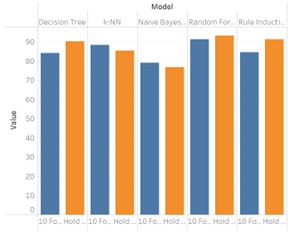Predicting Forest Fires using Five Machine Learning Algorithms
DOI:
https://doi.org/10.63017/jdsi.v2i2.114Keywords:
Forest Fires, Algorithm, Classification, Machine Learning, PredictingAbstract
This research aims to develop a prediction model for forest fires that occur by utilizing five types of machine learning algorithms, namely Decision Tree, K-Nearest Neighbors (KNN), Random Forest, Naïve Bayes (Kernel), and Rule Induction. The data used in this research was taken from [www.kaggle.com]. By using data pre-processing techniques such as missing value imputation, data normalization, and feature selection techniques, to ensure the quality of the data used in the prediction model. The research results show that each algorithm has different performance in predicting forest fires that occur each month, with some algorithms showing higher levels of accuracy and precision. Further analysis discusses the advantages and disadvantages of each algorithm as well as the practical implications of implementing them in the environment.
References
P. N. Utami and Y. Primawardani, "Efforts to Fulfill Environmental Rights Against Forest Fires for the People of Riau," J. Him, vol. 12, no. 3, pp. 367–384, 2021.
S. Gusty, E. Syarifudin, M. Adriansyah, J. Jamilah, E. Efrianto, and A. M. Fajrin, "Climate Change and Geotechnical Stability," Arsy Media, 2024.
I. Indra, L. Kamarubayana, and M. T. Tirkaamiana, "Study of Forest Fires 2015–2019 Based on the Sipongi Application Using Noaa Satellite Imagery in East Kalimantan Province," JAKT J. Agrotechnology and Forestry. Trop., vol. 2, no. 1, pp. 47–70, 2023.
M. Dede et al., "Estimation of changes in air quality based on remote sensing satellite imagery around PLTU Cirebon," Jambura Geosci. Rev., vol. 2, no. 2, pp. 78–87, 2020.
D. Fachruddin, Geographic Information Systems (GIS) in the Field of Agricultural Engineering. Aceh: Syiah Kuala University Press, 2021.
J. L. Farozan, K. Roudlotin, and Z. M. Rosyidah, "Framing Analysis of Reporting of the Mount Bromo Fire on Online News Media Republika.co.id and Liputan6.com," Pros Semin. Nas., pp. 687–701, 2023.
F. F. Rozani, F. Nuroktaviany, I. Nurjaman, I. A. Fajar, and D. Najmudin, "Analysis of Fire Cases in the Mount Bromo Land Area in the Use of Flares During Pre-Wedding Photos in the Perspective of Islamic Criminal Law," Tashdiq J. Kaji. Religion and preaching, vol. 1, no. 2, pp. 61–70, 2023.
F. Sulianta, Introduction to Data Science. Jakarta: Sulianta Ferry, 2024.
M. Ramdhan, Research methods. Jakarta: Cipta Media Nusantara, 2021.
Sudriyanto, M. A. Hafid, and M. A. Kurniawan, "Kaggle Bot Account Detection Using Linear Regression," J. Electr. Eng. Comput., vol. 6, no. 2, pp. 449–459, 2024, doi: 10.33650/jeecom.v4i2.
T. Saptadi et al., Data Mining. Medan: Cendikia Mulia Mandiri, 2024.
P.W. Rahayu et al., Data Mining Textbook. Jambi: PT. Sonpedia Publishing Indonesia, 2024.
T. Santhi, A. M. Sari, D. K. A. M. Putra, G. S. Mahendra, and Ma. P. Ariasih, "Implementation of Business Intelligence Using Tableau to Visualize Student Graduation Predictions," J. Softw. Eng. Inf. Syst., vol. 3, no. 2, pp. 66–73, 2023.
S. I. G. Mata, G. K. Pati, and K. W. Rato, "Data Mining Classification in Predicting Drug Sales at Healthy and Prosperous Pharmacies using the Frequent Pattern-Growth Method," J. Computer Science. and Business, vol. 16, no. 2, 2024.
T. Novianti, S. A. Mandati, and E. K. Andana, "Improving Credit Risk Evaluation Using Decision Tree C 4.5," J. Manuf. Ind. Eng. Technol., vol. 2, no. 2, pp. 1–9, 2023, doi: 10.30651/mine-tech.v2i2.21749.

Downloads
Published
How to Cite
Issue
Section
License
Copyright (c) 2025 Data Science Insights

This work is licensed under a Creative Commons Attribution-NonCommercial 4.0 International License.


 SUPPORT
SUPPORT







